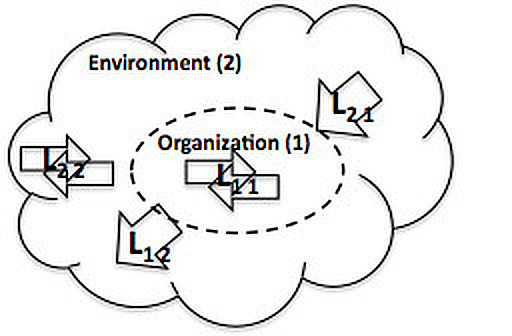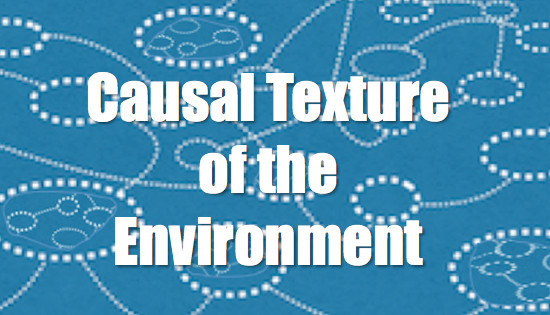For those who haven’t read the 1965 Emery and Trist article, its seems as though my colleague Doug McDavid was foresighted enough to blog a summary in 2016! His words have always welcomed here, as Doug was a cofounder of this web site. At the time of writing, the target audience for this piece was primarily Enterprise Architecture practitioners. [DI]
Published on February 4, 2016
This post is a quick summary (or reminder) of a seminal piece of work by Fred Emery and Eric Trist, which I personally think should be required reading for EA practitioners. We occasionally hear about outside-in thinking, and inside-out thinking, and this paper is a very good place to start to focus on these styles of thought about the architecture of enterprise.
The paper I’m referring to is named “The Causal Texture of Organizational Environments”*. Emery and Trist pioneered the idea of sociotechnical systems at the Tavistock Institute in London in the 1950s. There’s a lot that can be said about organizations as sociotechnical systems. For instance, it’s worth noting this quote from Wikipedia (as of 3 February, 2016):
“Sociotechnical theory … is about joint optimization, with a shared emphasis on achievement of both excellence in technical performance and quality in people’s work lives. Sociotechnical theory … proposes a number of different ways of achieving joint optimisation. They are usually based on designing different kinds of organisation, ones in which the relationships between socio and technical elements lead to the emergence of productivity and wellbeing.”
In this particular posting , I’m focusing in on one aspect of the work of Emery and Trist that they call the “causal texture” of the environment within which an organization operates. Here we get some insight into outside-in and inside-out thinking (as well as outside-out, and inside-in). I am specifically calling attention to this paper to set the stage in anticipation of my next posting on the ecosystems of enterprise.
Quoting from the paper:
“[A] comprehensive understanding of organizational behaviour requires some knowledge of each member of the following set, where L indicates some potentially lawful connection, and the suffix refers to the organization and the suffix to the environment:
L 1 1 , L 1 2
L 2 1, L 2 2
“L 1 1 here refers to processes within the organization – the area of internal interdependencies; L 1 2 and L 2 1 to exchanges between the organization and its environment – the area of transactional interdependencies from either direction; and L 2 2 to the processes through which parts of the environment become related to each other – i.e. its causal texture – the area of interdependencies that belong within the environment itself.”
Just for a bit of fun (!) let’s introduce the following graphic, that may prove to be useful in future discussions:

A key point here is the word ‘lawful’. The authors are trying to point out that there are very different systems of natural, psychological, (and artificial) laws that need to be considered for a full understanding of organizational situations. As they say “laws connecting parts of the environment to each other are often incommensurate with those connecting parts of the organization to each other, or even with those which govern the exchanges.”
The authors then proceed to lay out four types (steps) of causal texture:
- A “placid, randomized environment” is one where positive and negative forces are very stable, and simple organizations can succeed by simple tactics of trial and error.
- A “placid, clustered environment” exhibits systemic relationships between risks and rewards, where knowledge about patterns in the environment allows an organization to flourish under a tightly controlled strategy.
- A “disturbed-reactive environment” is one where there are multiple organizations that try to block each other from achieving their goals and reaping rewards. In other words, a competitive marketplace.
- “Turbulent fields” describe environments where there is not only competition among organizations, but the environment itself is in a state of constant flux. As the authors say, “lines of action that are strongly pursued may find themselves attenuated by emergent field forces.”
It seems fairly clear that the world of the 21st Century is very much a type 4 (or “Step 4”) environment. In such a situation, characterized by many moving parts, we can often observe the emergence of some stabilizing force. Emery and Trist suggest that such a force typically arises from the adoption of a set of shared values, or some kind of ethical code. Such a code of shared values provides a viable level of stability via “power fields” (in the words of Kurt Lewin).
“So far as effective values emerge, the character of richly joined, turbulent fields changes in a most striking fashion. The relevance of large classes of events … is given directly in the ethical code.” Thus “a field is created which is no longer richly joined and turbulent but simplified and relatively static. Such a transformation will be regressive, or constructively adaptive, according to how far the emergent values adequately represent the new environmental requirements.”
This set of concepts strikes me as one of those things that, once you’re aware of it, you start seeing everywhere. I don’t know, maybe it’s just me, but I enjoy having access to conceptual tools such as ‘causal textures’, ‘lawful connections’, and ‘values-based power fields’ to help understand and manage the forces of incoherence that our enterprises struggle with.
As I mentioned, I expect to refer back to this in my next post, which will focus on enterprise ecosystems. Happy trails, until then :-)
* A paper read at the XVII International Congress of Psychology, Washington, D.C., U.S.A., 20-26 August, 1963. http://ackoffcenter.blogs.com/ackoff_center_weblog/files/10.1177_001872676501800103.pdf
For an overview of these postings, see: https://www.linkedin.com/pulse/overview-postings-doug-mcdavid?published=u
Thanks for the digest, Doug!




